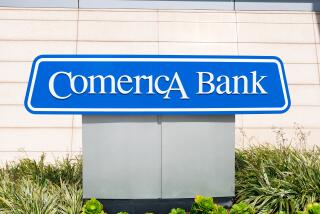Stress tests show banks improving
- Share via
WASHINGTON — All but one of the nation’s largest banks could withstand a severe recession, and the industry’s biggest players are much better positioned to blunt economic shocks than before the financial crisis, according to results of the latest Federal Reserve stress tests.
Ally Financial Inc. in Detroit, the only large bank still majority-owned by the government after the recession-era industry bailouts, would be at risk of failure under the Fed’s scenario. But none of the 17 other major banking firms would be near collapse if the economy tanked, according to the results released Thursday.
“This is just a confirmation that the industry has largely recovered from its problems,” said Bert Ely, an independent banking analyst.
QUIZ: How much do you know about the sequester?
Fed officials emphasized that banks could not pass or fail this set of stress tests because it did not take into account some important factors, such as their plans for issuing dividends.
Next week, the Fed will give what amounts to a pass/fail grade for the banks based on that additional information.
“The stress tests are a tool to gauge the resiliency of the financial sector,” said Fed Gov. Daniel K. Tarullo, who is in charge of the central bank’s regulatory functions.
“Significant increases in both the quality and quantity of bank capital during the past four years help ensure that banks can continue to lend to consumers and businesses, even in times of economic difficulty,” he said.
The Fed tested how each bank’s financial condition would be hurt under a worst-case scenario that envisions a severe recession deeper than the Great Recession.
At the lowest point in the severe-recession scenario, Ally would fall well below a key Fed measure of bank health. That gauge — the ratio of a bank’s capital to its risk-weighted assets — would drop to 1.5% for Ally at its lowest point in the scenario. Banks are supposed to stay above 5%.
Ally said Thursday that the stress test was “fundamentally flawed” and included projections for losses on auto financing that were “implausible, even in dire economic situations.”
For each of the other large banks, that ratio would remain above 5%. Taken together, the firms, which account for 70% of all U.S. banking assets, would have an average capital-to-assets ratio of 7.4% at their lowest point in the Fed’s “severely adverse” two-year economic scenario.
As of Sept. 30, the banks’ combined ratio was 11.1%. At the end of 2008, in the midst of the financial crisis, it was about 5%, Fed officials said.
Thursday’s results are the first in a two-step process this year that will take into account each bank’s plans to pay dividends and buy back stock — both of which affect how much capital firms have on hand to withstand a potential deep economic downturn.
The stress test results will be applied to each bank’s plans. Next week, the Fed will announce which firms can go ahead with those plans and which must raise more capital — a pass/fail determination similar to the 2009 and 2011 stress tests.
Based on the results released Thursday, a bank could lower its planned dividends and stock repurchases to try to gain approval for its plans next week, the Fed said. Last year, four banks that failed the tests — Ally, Citigroup Inc., SunTrust Banks Inc. and MetLife Inc. — had to adjust their planned dividends and stock buybacks.
The largest banks, including Bank of America Corp., JPMorgan Chase & Co. and Wells Fargo & Co., would be hit hard under the Fed’s severe economic scenario.
Combined, the 18 banks would suffer $462 billion in loan losses through the end of 2014 in a deep recession that sends unemployment to 12.1%, causes the stock market to lose half its value and knocks housing prices down more than 20%.
More to Read
Inside the business of entertainment
The Wide Shot brings you news, analysis and insights on everything from streaming wars to production — and what it all means for the future.
You may occasionally receive promotional content from the Los Angeles Times.











